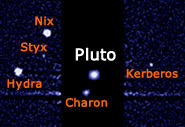Uncovering the Secrets of Pluto
 Agencies: Long before the icy dwarf planet Pluto was discovered on the outskirts of our solar system, amateur astronomer Percival Lowell began his search for an object he called “Planet X.” It was 1905, and, at the time, our solar system had eight known planets.
Agencies: Long before the icy dwarf planet Pluto was discovered on the outskirts of our solar system, amateur astronomer Percival Lowell began his search for an object he called “Planet X.” It was 1905, and, at the time, our solar system had eight known planets.
Astronomers had found Neptune, the eighth planet, in 1846 after noticing that Uranus, the planet’s next-door neighbor, had a slightly irregular motion around its orbit. Researchers calculated that the gravity of Neptune was tugging on Uranus and creating its inconsistent motion.
Lowell, along with some astronomers, extended this idea, and predicted there was at least one other planet orbiting far away in our solar system.
The hunt is on
Objects far away in our solar system are small pinpoints of light and are hard to see with the best telescopes. Lowell, however, was ready to give the search a try. He conducted a photographic search for Planet X using a telescope at his observatory in Arizona. Lowell hunted for the planet for 11 years before giving up in 1916. It would later be revealed that Pluto showed up in two of his images. The object was overlooked because it was much dimmer than anyone expected.
More than 10 years later, a young amateur astronomer named Clyde Tombaugh took up the search at Lowell’s Arizona observatory. Beginning in 1929, he spent 10 months photographing the sky, looking for any slight movement of objects over that time. While comparing two images taken in January 1930, Tombaugh found an object that changed position in the expected manner. The discovery of a new planet was officially announced on March 13, 1930.
Interestingly, Pluto’s size and orbit did not match the expectations for Planet X. In fact, Lowell’s predictions had been incorrect, and it is Tombaugh’s careful observing that really deserves credit for the discovery.
Pluto has a family
Astronomers would have to wait another 48 years before finding the first of Pluto’s five known moons. Charon, the largest and innermost moon, was discovered in 1978 with ground-based telescopes. The sharp vision of the Hubble Space Telescope spotted the other four, smaller, outer moons. Nix and Hydra were found in 2005; Kerberos in 2011; and Styx in 2012.
Charon, Pluto’s largest moon, is 746 miles (1,200 kilometers) across. Nix and Hydra range from 20 to 70 miles (32 to 113 kilometers) in diameter. Kerberos has an estimated diameter of 8 to 21 miles (13 to 34 kilometers), and Styx is estimated to be 6 to 15 miles (10 to 24 kilometers) across.
Borrowing names from Greek mythology
The names for Pluto and its family of moons come from Greek mythology. Discovered in 1930, Pluto was named for the Greek god of the underworld, who was perhaps better known as Hades. The moon, Charon, discovered in 1978, was named for the ferryman who carried souls to the underworld. Nix, one of two moons discovered in 2006 with Hubble, is named for Nyx, the goddess of the night and Charon’s mother. Hydra, the other moon spied in 2006, is named for the many-headed, serpent-like beast of ancient times. Kerberos, discovered in 2011, was named for the many-headed dog that guarded the entrance to the underworld. Styx, spotted in 2012, is the name of the goddess who ruled over the underworld river.
Pluto is demoted
During the flurry of Hubble observations of Pluto, the faraway object lost its planetary status. The International Astronomical Union (IAU) voted in 2006 to demote Pluto from planet to dwarf planet. The reason for the change is because Pluto is now known to be part of a vast collection of objects called the Kuiper Belt. The Kuiper Belt is a region beyond Neptune that contains small, icy objects much like the asteroid belt contains small, rocky objects. Pluto is the second-largest of five currently recognized dwarf planets. Eris, the largest dwarf planet, is only slightly bigger than Pluto.
Hubble view of Ceres
Pluto’s dismissal from the planetary ranks is not unusual. During the 1820s, astronomers counted 11 planets. Years later, several of them were dropped from the planetary list, including Ceres, now considered a dwarf planet. Ceres is the largest object in the asteroid belt.
The dwarf planet is full of surprises
Despite Pluto’s demotion, astronomers are still interested in the dwarf planet and its moons. In fact, recent Hubble observations of the frigid system have revealed another surprising discovery. Two of the moons, Nix and Hydra, are rotating chaotically as they orbit Pluto. If you lived on Nix or Hydra, you would have a hard time setting your alarm clock. You would not know when the Sun would rise or even in which direction it would rise. You might even have a hard time figuring out when to celebrate your birthday.
New Horizons mission:
In preparation for the New Horizons flyby, Hubble has been making detailed observations of Pluto and its neighborhood. Launched in 2006, the New Horizons spacecraft has been traveling for nine years to the far-flung dwarf planet. The satellite will arrive at the Pluto system on July 14, 2015, and will take the first detailed close-up views of the dwarf planet and its moons. Following that encounter, the spacecraft may study other objects in the Kuiper Belt.
